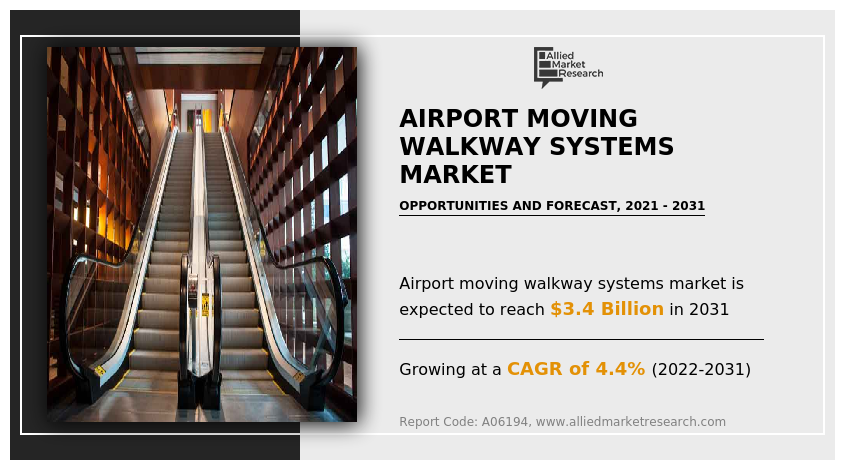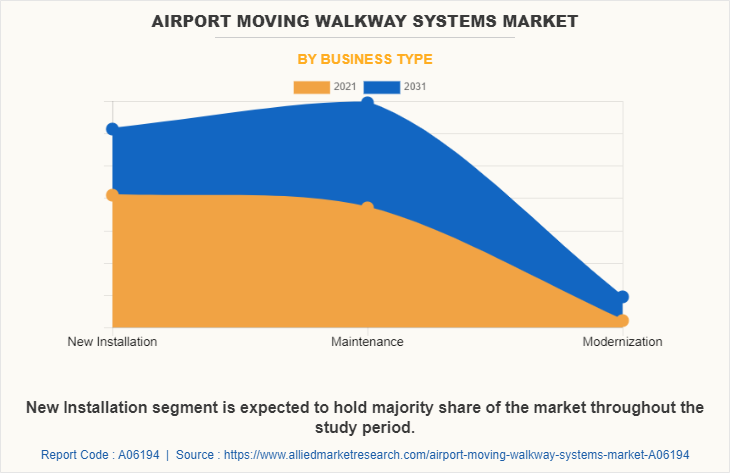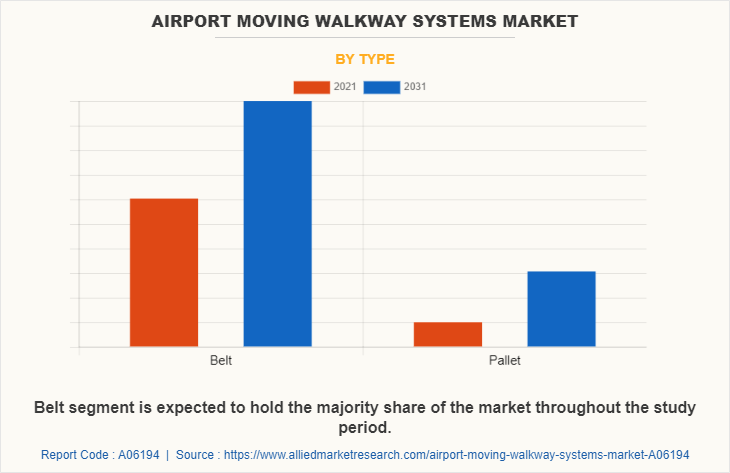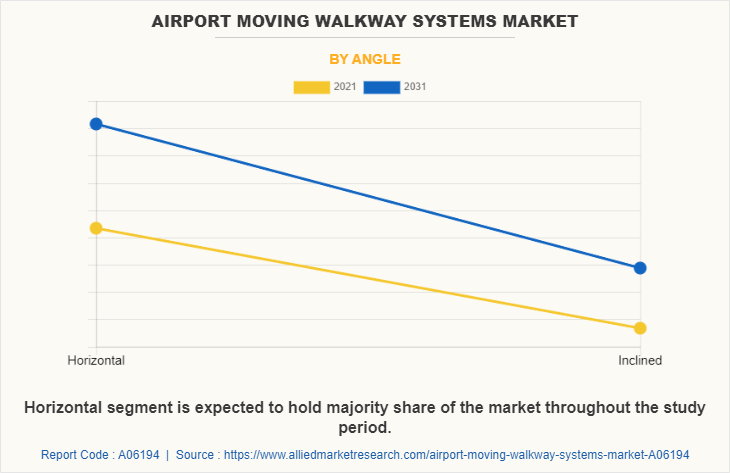Airport Moving Walkway Systems Market Research: 2031
The Global Airport Moving Walkway Systems Market Size was valued at $2.2 billion in 2021, and is projected to reach $3.4 billion by 2031, growing at a CAGR of 4.4% from 2022 to 2031.Moving walkway or moving sidewalk, also called as travelator, is a transport system that uses conveyor. The moving walkways move people safely and slowly over a short distance along the ground level or inclined between two floors of the building. Escalators and walkways have similar applications. People walk or stand on the conveyor and it starts to roll. Walkways are installed in pairs with opposite direction of rolling and have moving safety handrails alongside. These handrails roll into end comb-plate as the walkway ends.

Development of the airport moving walkway systems industry due to increase in number of air travelers at airports is a key factor propelling the market growth. In case of large airports where number of flights operated are more, the number of travelers is high. Therefore, smooth and safe commute of travelers from one place to another inside the airport itself is extremely important. Further, many airports are expanding their current infrastructure, which will drive the growth of the airport moving walkway systems market share.

Technological developments have made airport moving walkway systems efficient due to the use of energy-efficient components such as motors and LEDs. These factors drive the growth of the walkway systems market. However, the installation cost of walkways is high and the maintenance to replace any damaged component is expensive. If the walkway fails to operate or stops while operating, then the whole line will halt. This can cause delay in movement of passengers, thus affecting the growth of the market, as some architects do not prefer moving walkways due to the mentioned reasons. However, rise in number of travelers through air makes the airport crowded, and hence fast and safe commute of passengers is necessary. In addition, facilities provided in airports are advanced, and governments have started spending large amount on advanced technologies such as moving walkways to be installed in airports. This boosts the airport moving walkway systems market growth during the forecast period.

High cost of installation restrains some of the airports from adopting the moving walkways. This is majorly observed in developing countries of Asia, Latin America, and Africa. Furthermore, the cost of moving walkway not only depends on the distance it covers but also on other factors such as its vertical rise (if any), the material for lateral truss cladding, and the quality of the motors used. Therefore, the cost of installation is quite high for moving walkways. Furthermore, the maintenance frequency of the moving walkway depends on its use and the surrounding environment. Hence, the installation of a moving walkway needs to be justified for the benefits it is likely to provide at the airport. In addition, if an option of not installing a moving walkway does not hinder the airport’s operation, then the airport will not opt for the installation and save the capital or use it somewhere else. Such factor hinders market growth.

The demand for airport moving walkway systems decreased in the year 2020, owing to low demand from different regions due to lockdown imposed by the government of many countries. The COVID-19 pandemic has shut-down production of airport moving walkway systems for the end-user, mainly owing to prolonged lockdowns in major global countries. This has hampered the growth of the airport moving walkway systems market significantly during the pandemic. The major demand for airport moving walkway systems was previously noticed from giant manufacturing countries including China, U.S., Germany, Italy, and the UK, which was severely affected by the spread of coronavirus, thereby halting demand for airport moving walkway systems. This is expected to lead to re-initiation of manufacturing industry at their full-scale capacities, which is likely to help the airport moving walkway systems market to recover by end of 2022.
By Region
Asia-Pacific region is the largest market throughout the study period.
Increase in focus on energy-efficient systems is expected to offer opportunity during the forecast period. The energy use of moving walkways is considerable. To lower the operational cost of moving walkways, several businesses are offering solutions that are energy-efficient. For instance, Schindler offers energy-efficient inclined and horizontal pathways that use sophisticated power management, efficient motor systems, sustainable & recyclable materials, and low power components. In addition, one of the major energy consumers in a moving walkway system is the motor. The efficiency of a motor is inversely correlated with its energy consumption. Therefore, installing a high efficiency motor can reduce the effectiveness of a moving walkway. Therefore, the creation of inexpensive IE2, IE3, and IE4 motors is anticipated to spur the demand for moving walkways in the future. All such instances are anticipated to provides lucrative opportunities for growth of the airport moving walkway systems market.
Segmental Overview
The airport moving walkway system market is segmented on the basis of business type, type, angle, and region. Based on business type, the market is divided into new installation, modernization and maintenance. Based on type, the market is divided into belt type and pallet type. Based on angle, the market is divided into horizontal and inclined.
Region Wise:
The global airport moving walkway systems market analysis is conducted across North America (the U.S., Canada, and Mexico), Europe (the UK, France, Germany, Italy, and rest of Europe), Asia-Pacific (China, Japan, India, South Korea, and rest of Asia-Pacific), and LAMEA (Latin America, the Middle East, and Africa).
By Business Type:
The airport moving walkway systems market is categorized into new installation, modernization and maintenance. New installation of walkways is generally made while building new infrastructures. Moving walkways has become an integral part of airports. Hyundai, Hitachi, and Mitsubishi provide new moving walkways for airports. These companies are key manufacturers of airport walkways. Modernization of the moving walkways means upgrading existing moving walkways with new advanced technology or replacing the damaged walkway with the new one. The method includes removing all the electrical and mechanical parts from the existing framework of the currently installed moving walkway and then replacing them with new parts. Maintenance of the moving walkways includes timely servicing of the walkways to prevent them from getting damaged or stop working abruptly. In addition, maintenance is required for smooth functioning of the walkways and to avoid injuries to the travelers while using the facility. Replacing or repairing of damaged part also counts as maintenance of walkways. New Installation segment is expected to exhibit the largest revenue contributor during the forecast period. Maintenance segment is expected to exhibit the highest CAGR share in the business type segment in the airport moving walkway systems market during the forecast period.
By Type:
The airport moving walkway systems market is classified into belt and pallet. Belt type moving walkway systems are essentially human conveyor belts. These walkways are generally made of mesh metal balls of rubber surface over the metal rollers. Pallet type moving walkway system is a series of metal surfaces, which are flat and are joined together to form a walkway. Mostly the walkways have metal surfaces but occasionally sometimes rubber is used to provide extra traction. Belt segment is expected to exhibit largest revenue during forecast period. Pallet segment expected to exhibit highest CAGR share in type segment in airport moving walkway systems market during forecast period.
By Angle:
The airport moving walkway systems market is divided into horizontal and inclined. Horizontal moving walkways are installed at the ground level. These types of walkways are generally used for heavy transportation of travelers or luggage. Inclined moving walkways are inclined and generally installed across the floors. These type of walkways are generally inclined between the ranges of 10° to 12°. Further, the maximum height rise ranges from 5 meters to 8 meters vertically from the ground. Inclined walkways are little expensive to install and operate compared to horizontal walkways. Horizontal segment is expected to exhibit the largest revenue share in the angle segment in the airport moving walkway systems market during the forecast period. The inclined segment is expected to exhibit the largest CAGR during the forecast period.
By Region:
The airport moving walkway systems market is analyzed across North America, Europe, Asia-Pacific, and LAMEA. In 2021, Asia-Pacific had the highest revenue in airport moving walkway systems market share. And LAMEA is expected to exhibit highest CAGR during forecast period.
COMPETITION ANALYSIS
The major players profiled in the in the airport moving walkway systems market are Analogue Holdings Limited (ATAL Engineering Group), Fujitec Co., Ltd, Toshiba Elevator and Building Systems Corporation, Hitachi, Ltd., Hyundai Elevator Co., Ltd., Kone Corporation, Mitsubishi Electric Corporation, Raytheon Technologies Corporation, Schindler, and Stannah.
Major companies in the market have adopted acquisition and product launch as their key developmental strategies to offer better products and services to customers in the airport moving walkway systems market.
Some examples of collaboration and acquisition in the market
In March 2022, Mitsubishi Electric Corporation has acquired Sweden-based Motum AB, which operates an elevator and automatic door business mainly in Sweden. By means of this acquisition, Mitsubishi Electric aims to strengthen its capabilities to service and modernize elevators and escalators in Sweden and other countries not limited to Europe.
In February 2022, Schindler has collaborated with CitizenM hotels, the leading Netherlands-based boutique hotel chain, to provide service and modernization for escalators and elevators in all of the group’s existing buildings across the globe, as well as the installation of future vertical mobility solutions in the chain’s new hotels.
The product launch in the market
In November 2021, Mitsubishi Electric Corporation has launched its new Diamond-Trac 2, a new Diamond-Trac Series machine room-less elevator featuring a space-saving design, enhanced operational efficiency and a touchless hall operating panel for residences, offices and hotels in the U.S. market.
In October 2021, Mitsubishi Electric Corporation launched its new NEXIEZ-MRL Version2 elevator, featuring more advanced specifications than the NEXIEZ-MRL model, the company's mainstay machine room-less elevator in overseas markets. In addition to operating more efficiently, the new model will help improve passenger safety, comfort, and convenience by providing antivirus solutions that meet the demands of the "new normal.".
In June 2021, Mitsubishi Electric Corporation developed its Ryoden Dumbwaiter G-Series to provide more reliable and environment-friendly model. The Ryoden Dumbwaiter G-Series has a wide range of applications and is practical and simple to use in any environment.
In May 2021, KONE, a global leader in the elevator and escalator industry, has develops a new tech solution designed to enable wheelchair users to navigate modern buildings more easily by connecting elevators and wheelchairs.
Key Benefits For Stakeholders
- This report provides a quantitative analysis of the market segments, current trends, estimations, and dynamics of the airport moving walkway systems market analysis from 2021 to 2031 to identify the prevailing airport moving walkway systems market opportunities.
- The market research is offered along with information related to key drivers, restraints, and opportunities.
- Porter's five forces analysis highlights the potency of buyers and suppliers to enable stakeholders make profit-oriented business decisions and strengthen their supplier-buyer network.
- In-depth analysis of the airport moving walkway systems market forecast and segmentation assists to determine the prevailing market opportunities.
- Major countries in each region are mapped according to their revenue contribution to the global market.
- Market player positioning facilitates benchmarking and provides a clear understanding of the present position of the market players.
- The report includes the analysis of the regional as well as global airport moving walkway systems market trends, key players, market segments, application areas, and market growth strategies.
Airport Moving Walkway Systems Market Report Highlights
| Aspects | Details |
| Market Size By 2031 | USD 3.4 billion |
| Growth Rate | CAGR of 4.4% |
| Forecast period | 2021 - 2031 |
| Report Pages | 210 |
| By Business Type |
|
| By Type |
|
| By Angle |
|
| By Region |
|
| Key Market Players | Hyundai Elevator Ltd, Toshiba Elevator and Building Systems Corporation, Hitachi, Ltd., Schindler, Analogue Holdings Limited (ATAL Engineering Group), Fujitec Co., Ltd, Stannah, Raytheon Technologies Corporation, Kone Corporation, Mitsubishi Electric Corporation |
Analyst Review
According to the perspective of CXOs of leading companies, the airport moving walkway systems market holds high potential in the maintenance segment. Furthermore, various types of airport moving walkway systems are available in the market, however, choosing the right type of airport moving walkway systems is imperative. While selecting airport moving walkway systems, industries focus on parameters such as the complexity of the project, material, cost, quality, time, and safety.
Airport moving walkway systems are specially designed machinery for transport system, which uses conveyor belt. The moving walkway systems move travelers or commuters safely and slowly over a medium to long distance along the ground level or inclined between two floors of the airport building.
The airport moving walkway systems market covers different segments such as business type, type, angle and region. Asia-Pacific secured the highest share in the airport moving walkway systems market in the past few years and is expected to dominate the market during the forecast period, owing to increase in demand for new construction and maintenance of moving walkways.
The major players profiled in the in the airport moving walkway systems market are Analogue Holdings Limited (ATAL Engineering Group), Fujitec Co., Ltd, Toshiba Elevator and Building Systems Corporation, Hitachi, Ltd., Hyundai Elevator Co., Ltd., Kone Corporation, Mitsubishi Electric Corporation, Raytheon Technologies Corporation, Schindler, and Stannah.
The global airport moving walkway systems market was valued at $2,200.8 million in 2021 and is projected to reach $3,406.9 million by 2031, registering a CAGR of 4.4% from 2022 to 2031.
The forecast period considered for the global airport moving walkway systems market is 2022 to 2031, wherein, 2021 is the base year, 2022 is the estimated year, and 2031 is the forecast year.
The latest version of global airport moving walkway systems market report can be obtained on demand from the website.
The base year considered in the global airport moving walkway systems market report is 2021.
The major players profiled in the airport moving walkway systems market include Analogue Holdings Limited (ATAL Engineering Group), Fujitec Co., Ltd, Toshiba Elevator and Building Systems Corporation, Hitachi, Ltd., Hyundai Elevator Co., Ltd., Kone Corporation, Mitsubishi Electric Corporation, Raytheon Technologies Corporation, Schindler, and Stannah.
The top ten market players are selected based on two key attributes - competitive strength and market positioning.
The report contains an exclusive company profile section, where leading companies in the market are profiled. These profiles typically cover company overview, geographical presence, market dominance (in terms of revenue and volume sales), various strategies and recent developments.
Based on type, the belt type segment dominated the market in 2021.
Loading Table Of Content...


